An official website of the United States government
 United States Department of Labor
United States Department of Labor
Provide information by accessing alphabetical, geographical, or other directories. Assist customers with special billing requests, such as charges to a third party and credits or refunds for incorrectly dialed numbers or bad connections. May handle emergency calls and assist children or people with physical disabilities to make telephone calls.
Employment estimate and mean wage estimates for Telephone Operators:
| Employment (1) | Employment RSE (3) |
Mean hourly wage |
Mean annual wage (2) |
Wage RSE (3) |
|---|---|---|---|---|
| 4,630 | 7.4 % | $ 18.91 | $ 39,340 | 1.5 % |
Percentile wage estimates for Telephone Operators:
| Percentile | 10% | 25% | 50% (Median) |
75% | 90% |
|---|---|---|---|---|---|
| Hourly Wage | $ 12.02 | $ 14.15 | $ 18.13 | $ 23.41 | $ 28.08 |
| Annual Wage (2) | $ 25,000 | $ 29,430 | $ 37,710 | $ 48,700 | $ 58,410 |
Industries with the highest published employment and wages for Telephone Operators are provided. For a list of all industries with employment in Telephone Operators, see the Create Customized Tables function.
Industries with the highest levels of employment in Telephone Operators:
| Industry | Employment (1) | Percent of industry employment | Hourly mean wage | Annual mean wage (2) |
|---|---|---|---|---|
| General Medical and Surgical Hospitals | 1,170 | 0.02 | $ 18.45 | $ 38,380 |
| Telecommunications | 720 | 0.10 | $ 23.35 | $ 48,560 |
| Offices of Physicians | 630 | 0.02 | $ 15.09 | $ 31,390 |
| Local Government, excluding schools and hospitals (OEWS Designation) | 300 | 0.01 | $ 21.40 | $ 44,520 |
| Traveler Accommodation | 230 | 0.02 | $ 16.43 | $ 34,180 |
Industries with the highest concentration of employment in Telephone Operators:
| Industry | Employment (1) | Percent of industry employment | Hourly mean wage | Annual mean wage (2) |
|---|---|---|---|---|
| Telecommunications | 720 | 0.10 | $ 23.35 | $ 48,560 |
| Specialty (except Psychiatric and Substance Abuse) Hospitals | 110 | 0.04 | $ 20.56 | $ 42,760 |
| Offices of Physicians | 630 | 0.02 | $ 15.09 | $ 31,390 |
| Other Ambulatory Health Care Services | 60 | 0.02 | $ 15.55 | $ 32,330 |
| General Medical and Surgical Hospitals | 1,170 | 0.02 | $ 18.45 | $ 38,380 |
Top paying industries for Telephone Operators:
| Industry | Employment (1) | Percent of industry employment | Hourly mean wage | Annual mean wage (2) |
|---|---|---|---|---|
| Junior Colleges | 40 | 0.01 | $ 26.19 | $ 54,460 |
| Telecommunications | 720 | 0.10 | $ 23.35 | $ 48,560 |
| Computer Systems Design and Related Services | (8) | (8) | $ 21.72 | $ 45,170 |
| Local Government, excluding schools and hospitals (OEWS Designation) | 300 | 0.01 | $ 21.40 | $ 44,520 |
| Specialty (except Psychiatric and Substance Abuse) Hospitals | 110 | 0.04 | $ 20.56 | $ 42,760 |
States and areas with the highest published employment, location quotients, and wages for Telephone Operators are provided. For a list of all areas with employment in Telephone Operators, see the Create Customized Tables function.
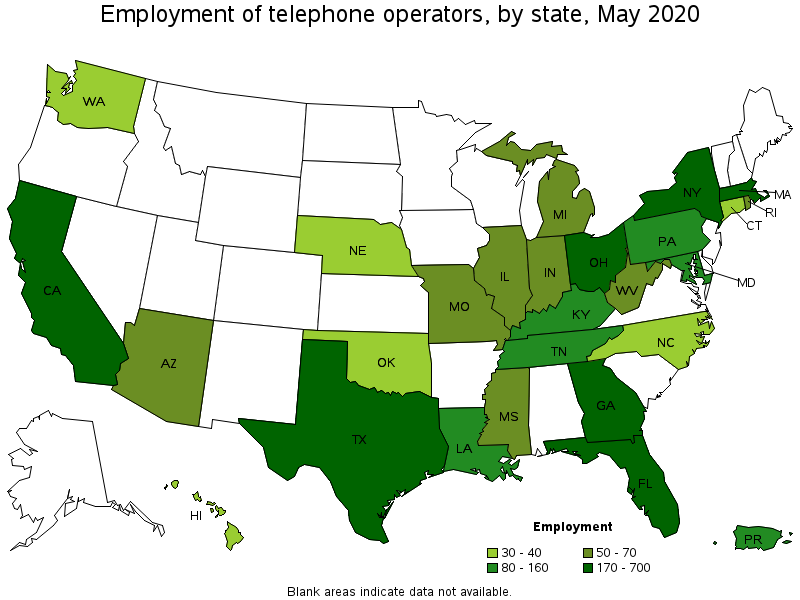
States with the highest employment level in Telephone Operators:
| State | Employment (1) | Employment per thousand jobs | Location quotient (9) | Hourly mean wage | Annual mean wage (2) |
|---|---|---|---|---|---|
| New York | 700 | 0.08 | 2.41 | $ 22.37 | $ 46,540 |
| California | 470 | 0.03 | 0.86 | $ 21.48 | $ 44,690 |
| Ohio | 360 | 0.07 | 2.11 | $ 14.21 | $ 29,550 |
| Georgia | 250 | 0.06 | 1.73 | $ 16.77 | $ 34,880 |
| Texas | 210 | 0.02 | 0.51 | $ 17.10 | $ 35,560 |
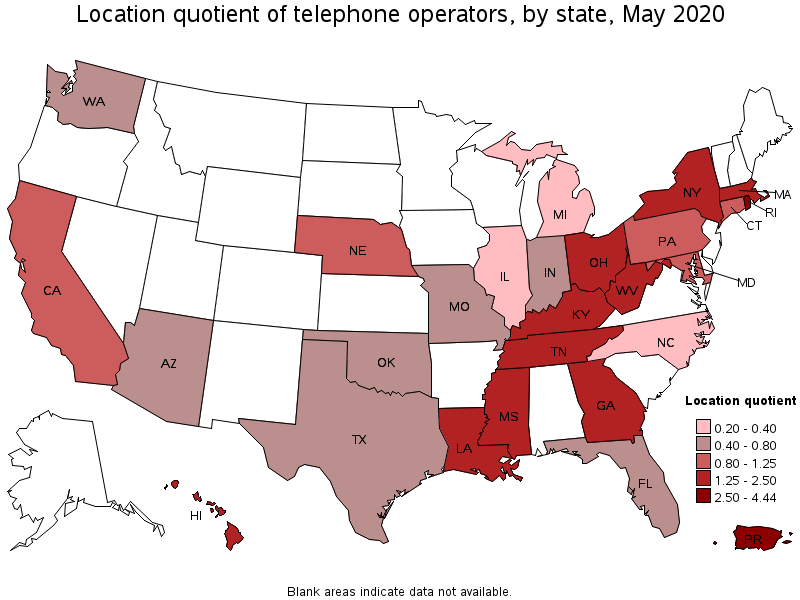
States with the highest concentration of jobs and location quotients in Telephone Operators:
| State | Employment (1) | Employment per thousand jobs | Location quotient (9) | Hourly mean wage | Annual mean wage (2) |
|---|---|---|---|---|---|
| Rhode Island | 50 | 0.11 | 3.21 | $ 19.53 | $ 40,630 |
| West Virginia | 50 | 0.08 | 2.48 | $ 14.03 | $ 29,190 |
| New York | 700 | 0.08 | 2.41 | $ 22.37 | $ 46,540 |
| Ohio | 360 | 0.07 | 2.11 | $ 14.21 | $ 29,550 |
| Hawaii | 40 | 0.06 | 1.87 | $ 19.21 | $ 39,960 |
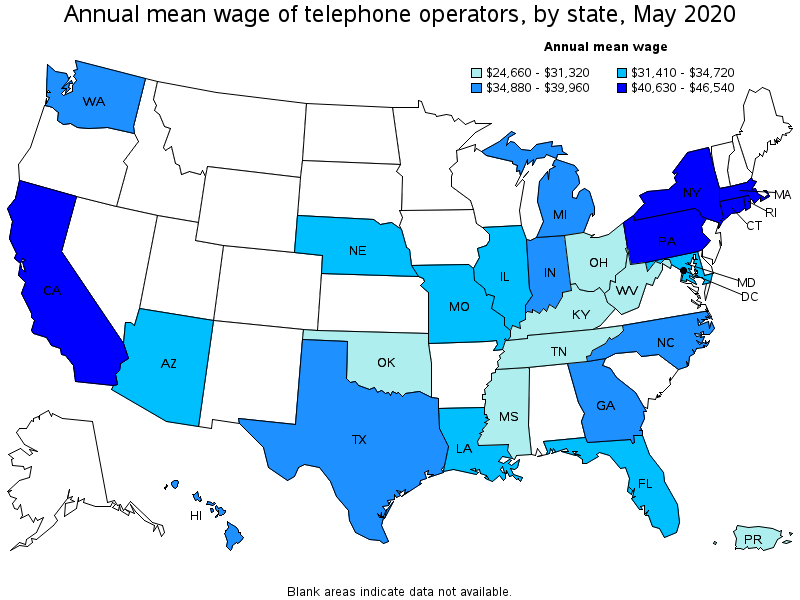
Top paying states for Telephone Operators:
| State | Employment (1) | Employment per thousand jobs | Location quotient (9) | Hourly mean wage | Annual mean wage (2) |
|---|---|---|---|---|---|
| New York | 700 | 0.08 | 2.41 | $ 22.37 | $ 46,540 |
| District of Columbia | (8) | (8) | (8) | $ 22.00 | $ 45,770 |
| Massachusetts | 180 | 0.05 | 1.63 | $ 21.51 | $ 44,750 |
| California | 470 | 0.03 | 0.86 | $ 21.48 | $ 44,690 |
| Pennsylvania | 160 | 0.03 | 0.88 | $ 20.32 | $ 42,270 |
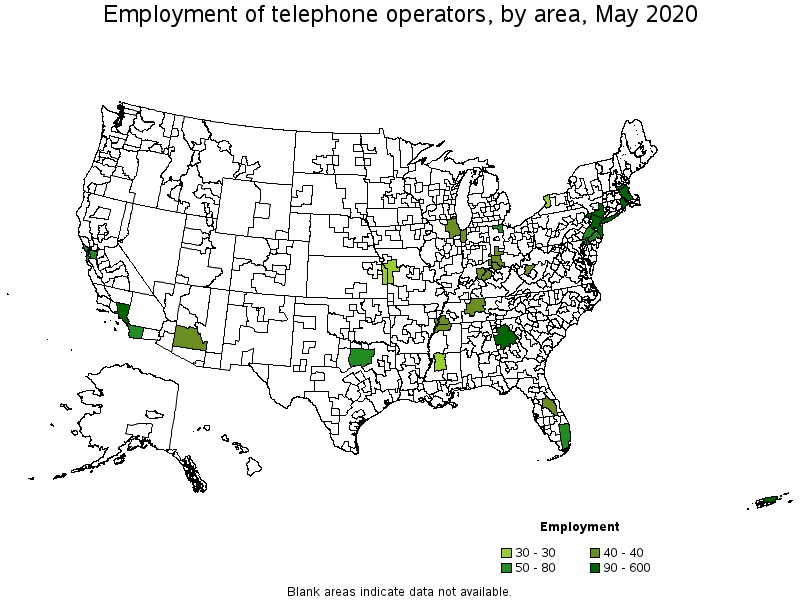
Metropolitan areas with the highest employment level in Telephone Operators:
| Metropolitan area | Employment (1) | Employment per thousand jobs | Location quotient (9) | Hourly mean wage | Annual mean wage (2) |
|---|---|---|---|---|---|
| New York-Newark-Jersey City, NY-NJ-PA | 600 | 0.07 | 2.03 | $ 22.93 | $ 47,680 |
| Atlanta-Sandy Springs-Roswell, GA | 160 | 0.06 | 1.79 | $ 18.14 | $ 37,730 |
| Los Angeles-Long Beach-Anaheim, CA | 100 | 0.02 | 0.53 | $ 23.09 | $ 48,030 |
| Boston-Cambridge-Nashua, MA-NH | 100 | 0.04 | 1.10 | $ 20.16 | $ 41,920 |
| Providence-Warwick, RI-MA | 90 | 0.18 | 5.30 | $ 23.46 | $ 48,800 |
| Philadelphia-Camden-Wilmington, PA-NJ-DE-MD | 80 | 0.03 | 0.93 | $ 19.17 | $ 39,870 |
| San Francisco-Oakland-Hayward, CA | 70 | 0.03 | 0.87 | $ 23.77 | $ 49,440 |
| San Diego-Carlsbad, CA | 60 | 0.05 | 1.37 | $ 21.45 | $ 44,620 |
| Toledo, OH | 60 | 0.20 | 6.05 | $ 15.27 | $ 31,770 |
| Miami-Fort Lauderdale-West Palm Beach, FL | 50 | 0.02 | 0.59 | $ 15.06 | $ 31,320 |
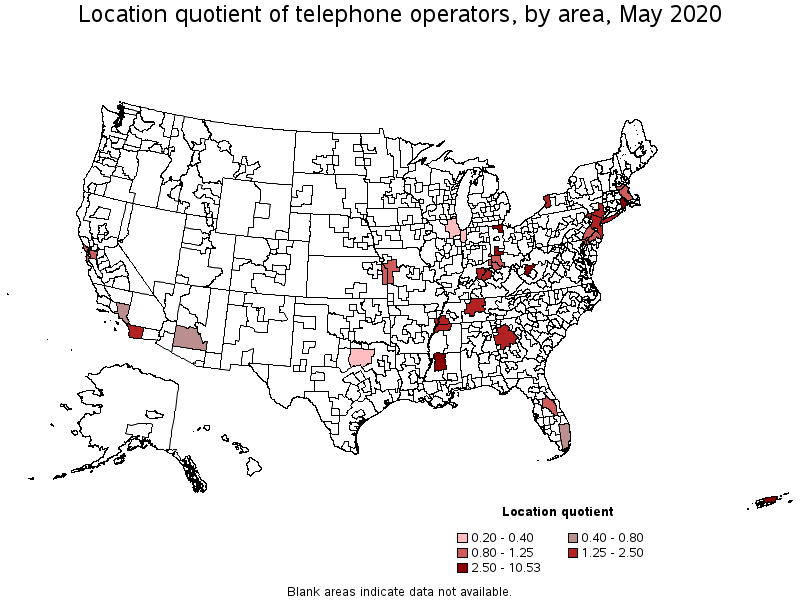
Metropolitan areas with the highest concentration of jobs and location quotients in Telephone Operators:
| Metropolitan area | Employment (1) | Employment per thousand jobs | Location quotient (9) | Hourly mean wage | Annual mean wage (2) |
|---|---|---|---|---|---|
| Charleston, WV | 40 | 0.35 | 10.53 | $ 15.00 | $ 31,200 |
| Toledo, OH | 60 | 0.20 | 6.05 | $ 15.27 | $ 31,770 |
| Providence-Warwick, RI-MA | 90 | 0.18 | 5.30 | $ 23.46 | $ 48,800 |
| Jackson, MS | 30 | 0.12 | 3.59 | $ 13.86 | $ 28,830 |
| Dayton, OH | 40 | 0.10 | 3.04 | $ 16.55 | $ 34,420 |
| Memphis, TN-MS-AR | 40 | 0.07 | 2.15 | $ 14.69 | $ 30,550 |
| Louisville/Jefferson County, KY-IN | 40 | 0.07 | 2.10 | $ 15.33 | $ 31,880 |
| Buffalo-Cheektowaga-Niagara Falls, NY | 30 | 0.07 | 2.04 | $ 19.60 | $ 40,760 |
| New York-Newark-Jersey City, NY-NJ-PA | 600 | 0.07 | 2.03 | $ 22.93 | $ 47,680 |
| Atlanta-Sandy Springs-Roswell, GA | 160 | 0.06 | 1.79 | $ 18.14 | $ 37,730 |
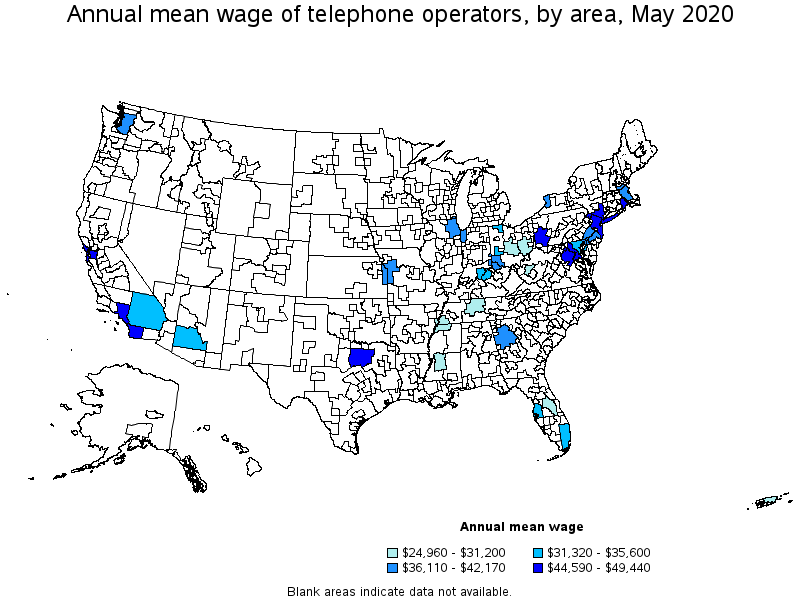
Top paying metropolitan areas for Telephone Operators:
| Metropolitan area | Employment (1) | Employment per thousand jobs | Location quotient (9) | Hourly mean wage | Annual mean wage (2) |
|---|---|---|---|---|---|
| San Francisco-Oakland-Hayward, CA | 70 | 0.03 | 0.87 | $ 23.77 | $ 49,440 |
| Providence-Warwick, RI-MA | 90 | 0.18 | 5.30 | $ 23.46 | $ 48,800 |
| Los Angeles-Long Beach-Anaheim, CA | 100 | 0.02 | 0.53 | $ 23.09 | $ 48,030 |
| New York-Newark-Jersey City, NY-NJ-PA | 600 | 0.07 | 2.03 | $ 22.93 | $ 47,680 |
| Pittsburgh, PA | (8) | (8) | (8) | $ 22.69 | $ 47,190 |
| Washington-Arlington-Alexandria, DC-VA-MD-WV | (8) | (8) | (8) | $ 21.75 | $ 45,250 |
| San Diego-Carlsbad, CA | 60 | 0.05 | 1.37 | $ 21.45 | $ 44,620 |
| Dallas-Fort Worth-Arlington, TX | 50 | 0.01 | 0.39 | $ 21.44 | $ 44,590 |
| Cincinnati, OH-KY-IN | 40 | 0.04 | 1.11 | $ 20.27 | $ 42,170 |
| Boston-Cambridge-Nashua, MA-NH | 100 | 0.04 | 1.10 | $ 20.16 | $ 41,920 |
These estimates are calculated with data collected from employers in all industry sectors, all metropolitan and nonmetropolitan areas, and all states and the District of Columbia. The top employment and wage figures are provided above. The complete list is available in the downloadable XLS files.
The percentile wage estimate is the value of a wage below which a certain percent of workers fall. The median wage is the 50th percentile wage estimate—50 percent of workers earn less than the median and 50 percent of workers earn more than the median. More about percentile wages.
(1) Estimates for detailed occupations do not sum to the totals because the totals include occupations not shown separately. Estimates do not include self-employed workers.
(2) Annual wages have been calculated by multiplying the hourly mean wage by a "year-round, full-time" hours figure of 2,080 hours; for those occupations where there is not an hourly wage published, the annual wage has been directly calculated from the reported survey data.
(3) The relative standard error (RSE) is a measure of the reliability of a survey statistic. The smaller the relative standard error, the more precise the estimate.
(8) Estimate not released.
(9) The location quotient is the ratio of the area concentration of occupational employment to the national average concentration. A location quotient greater than one indicates the occupation has a higher share of employment than average, and a location quotient less than one indicates the occupation is less prevalent in the area than average.
Other OEWS estimates and related information:
May 2020 National Occupational Employment and Wage Estimates
May 2020 State Occupational Employment and Wage Estimates
May 2020 Metropolitan and Nonmetropolitan Area Occupational Employment and Wage Estimates
May 2020 National Industry-Specific Occupational Employment and Wage Estimates
Last Modified Date: March 31, 2021